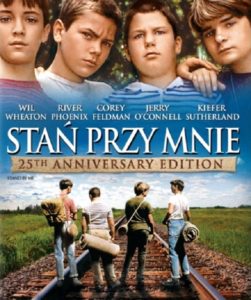Stand by me
Justyna Rybicka, Honorata Solenik
Studentki Instytutu Filologii Angielskiej Uniwersytetu Wrocławskiego (pod kierunkiem dr Justyny Deszcz-Tryhubczak)
A sleeper hit, „Stand by Me” (1986) took American cinemas by storm in the summer of that year. Starring River Phoenix, Jerry O’Connell, Corey Feldman and Will Wheaton, the film became a classic over the years, taking generation after generation on a truly nostalgic journey. The screenplay, gaining Raynold Gideon and Bruce A. Evans an Academy Award nomination, is based on the short story „The Body” by Stephen King.
The plot revolves around four boys — Gordie, Chris, Teddy and Vern — going on a quest into the woods to find a dead body of one of their peers. What seems like a typically boyish adventure turns into a meaningful, almost therapeutic journey to self-discovery as we see the struggles each boy has to face. Despite the simplicity of the story, the film still attracts new audiences. Why? Because it is relatable, emotional; and although we would not call it Oscar worthy, we can witness a solid and convincing acting under the meticulous eye of the director Rob Reiner. As the characters and the story are considerably close to their original material, the film gave justice to King’s work. The writer himself even admitted that he considers „Stand by Me” to be the first successful film adaptation of his work. What makes this film so enjoyable is its nostalgic dimension introduced mainly by the storyline revolving around children. On the one hand, the plot and the characters are constructed in a typical family film: rowdy boys going on an adventure, talking about „adult stuff” in a characteristic childlike and naive way. Their journey is filled with crazy yet endearing moments like running away from a roused dog or freaking out over leeches. All of this is accompanied by a happy, up-beat music of the 50s and 60s. On the other hand, such scenes are merely a comic relief, a distraction from the true, much darker motifs of the film such as abuse, alcoholism, death, and anxiety about one’s future. What is more, such experiences are typically attributed with stripping children from their innocence and forcing them to mature much too quickly. The juxtaposition of the boys and teenagers only enhances this unfair passage. The former are bullied and intimidated by the teens, who themselves struggle with their transition into adulthood, probably after experiencing a similar irregular and hurried development.
These topics, grim as they can be, are universal for all ages, cultures and classes. That is why „Stand by Me” is such a relatable film. We all have experienced some of these problems in our lives and because we see it happening to children, we feel an even stronger connection, for not only are the children viewed as innocent in most cultures but also being a child is a common denominator for all of us. All of these factors contribute to viewers identifying and sympathizing with the characters, and where there is an emotional attachment, there is nostalgia. It is easy to come back to this film again and again as by growing up we understand the boys’ issues more and we see them from a new perspective.
Przypisy:
Recenzja filmowa przygotowana przez studentów Instytutu Filologii Angielskiej Uniwersytetu Wrocławskiego pod kierunkiem dr Justyny Deszcz-Tryhubczak. Tekst został przygotowany w ramach dwóch kursów dotyczących obrazów dzieciństwa i młodości w kinie anglojęzycznym (semestr jesienny 2015/2016). Kursy te stanowią integralną część programu zajęć dotyczących kultury dziecięcej i młodzieżowej, opracowanego przez Pracownię Literatury oraz Kultury Dziecięcej i Młodzieżowej (http://cyplc.wordpress.com/), działającą przy Instytucie.

